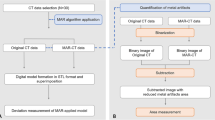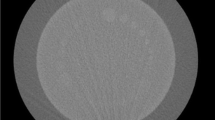Abstract
The 3D representation of CT scans is widely used in medical application such as virtual endoscopy, plastic reconstructive surgery, dental implant planning systems and more. Metallic objects present in CT studies cause strong artifacts like beam hardening and streaking, what difficult to a large extent the 3D reconstruction. Previous works in this field use projection data in different ways with the aim of artifact reduction. But in DICOM-based applications this information is not available, thus the need for a new point of view regarding this issue. Our aim is to present an exhaustive study of the state of the art and to evaluate a new approach based in mathematical morphology in polar domain in order to reduce the noise but preserving dental structures, valid for real-time applications.
This work has been supported by the project MIRACLE (DPI2007-66782-C03-01-AR07) of Spanish Ministerio de Educación y Ciencia.
Preview
Unable to display preview. Download preview PDF.
Similar content being viewed by others
References
Rohlfing, T., Zerfowski, D., Beier, J., Hosten, N., Wust, P., Felix, R.: Reduction of metal artifacts in computed tomographies for planning and simulation of radiation therapy. Computer Assisted Radiology and Surgery, 57–62 (1998)
Watzke, O., Kallender, W.: A pragmatic approach to metal artifact reduction in CT: merging of metal artifact reduced images. European Radiology 14, 849–856 (2004)
Yu, H., Zeng, K., Bharkhada, D., Wang, G., Madsen, M., Saba, O., Policeni, B., Howard, M., Smoker, W.: A segmentation-based method for metal artifact reduction. Academic Radiology 14(4), 495–504 (2007)
Kalender, W., Hebel, R., Ebersberger, J.: Reduction of CT artifacts caused by metallic implants. Radiology 164, 576–577 (1987)
Shiying, Z., Kyongtae, T., Whiting, B., Wang, G.: A wavelet method for metal artifact reduction with multiple metalic objects in the field of view. Journal of X-Ray Science and Technology 10, 67–76 (2002)
Tognola, G., Parazzini, M., Pedretti, G., Ravazzani, P., Grandori, F., Pesatori, A., Norgia, M., Svelto, C.: Novel 3D reconstruction method for mandibular distraction planning. In: International Workshop on Imaging Systems and Techniques, pp. 82–85 (2006)
Sohmura, T., Hojoh, H., Kusumoto, N., Nishida, M., Wakabayashi, K., Takahashi, J.: A novel method of removing artifacts because of metallic dental restorations in 3D CT images of jaw bone. Clinical Oral Implant Research 16, 728–735 (2005)
Wang, G., Snyder, D., O’Sullivan, J., Vannier, M.: Iterative deblurring for CT metal artifact reduction. IEEE Transactions on Medical Imaging 15(5), 657–664 (1996)
Murphy, R., Snyder, D., Politte, D., O’Sullivan, J.: A sieve-regularized image reconstruction algorithm with pose search in transmission tomography. In: SPIE Medical Imaging 2003: Image Processing conference (2003)
Naranjo, V., Albiol, A., Mossi, J., Albiol, A.: Morphological lambda-reconstruction applied to restoration of blotches in old films. In: 4th IASTED International Conference on Visualisation, Imaging and Image Processing (2004)
Serra, J.: Image analysis and mathematical morphology. Academic Press, London (1982)
Serra, J., Vincent, L.: An overview of morphological filtering. Circuits, Systems, and Signal Processing 11(1), 47–108 (1992)
Luengo-Oroz, M., Angulo, J., Flandrin, G., Klossa, J.: Mathematical morphology in polar-logarithmic coordinates. In: Marques, J.S., Pérez de la Blanca, N., Pina, P. (eds.) IbPRIA 2005. LNCS, vol. 3523, pp. 199–206. Springer, Heidelberg (2005)
Author information
Authors and Affiliations
Editor information
Editors and Affiliations
Rights and permissions
Copyright information
© 2009 Springer-Verlag Berlin Heidelberg
About this paper
Cite this paper
Naranjo, V., Llorens, R., Paniagua, P., Alcañiz, M., Albalat, S. (2009). A New Approach in Metal Artifact Reduction for CT 3D Reconstruction. In: Mira, J., Ferrández, J.M., Álvarez, J.R., de la Paz, F., Toledo, F.J. (eds) Bioinspired Applications in Artificial and Natural Computation. IWINAC 2009. Lecture Notes in Computer Science, vol 5602. Springer, Berlin, Heidelberg. https://doi.org/10.1007/978-3-642-02267-8_2
Download citation
DOI: https://doi.org/10.1007/978-3-642-02267-8_2
Publisher Name: Springer, Berlin, Heidelberg
Print ISBN: 978-3-642-02266-1
Online ISBN: 978-3-642-02267-8
eBook Packages: Computer ScienceComputer Science (R0)




